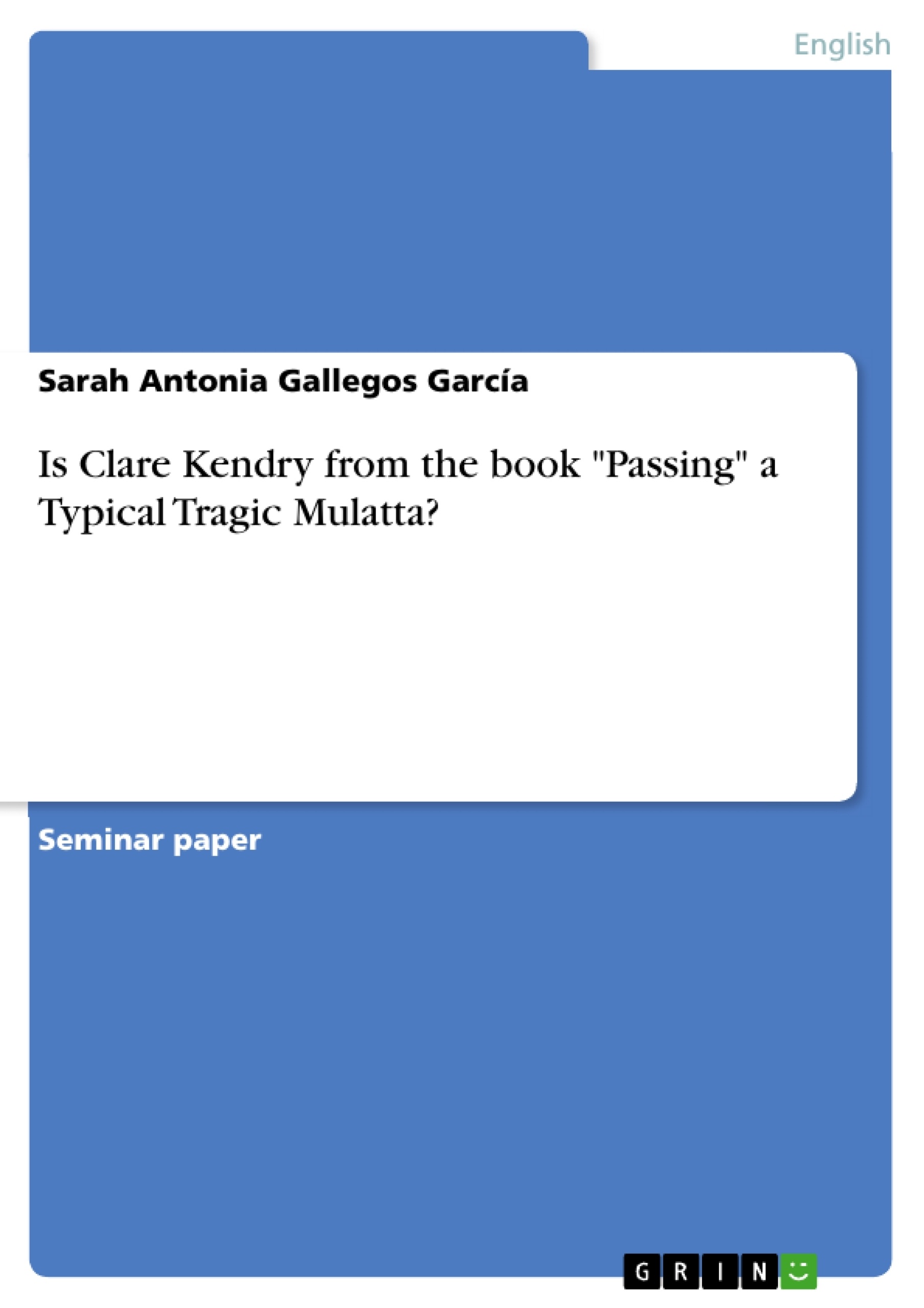This research paper will focus on "The Tragic Mulatta" in relation to Nella Larsen’s book "Passing" and will examine if Clare Kendry is a typical Tragic Mulatta or not.It is a well-known fact that there are a lot of stereotypes which developed over time, especially in the minds of people and in literature. For example the so called "Blackface", "The Uncle Tom", "The Coon", "The Mammy", "The Brutal Black Buck" and last but not least "The Tragic Mulatta". To this end the definition of this stereotype has to be considered: Dr. David Pilgrim, a Professor of Sociology defines "The Tragic Mulatta" as a female character with white appearance but also containing black blood, who could easily pass for white. A second fact included in the definition of Dr. Pilgrim is, that those Mulattas were often not aware of their black heritage and when they found out tragically committed suicide.
Another definition declares that the Mulattas always deny and "abandon their black families". They are also considered to be very seductive and sexual. Some definitions even say "they find only peace in death and live a life of alcoholism, depressions and sexual perversion" because they have a feeling of not being accepted in either of the two worlds. In the following paragraphs the fact will be proved that Clare Kendry is a typical Tragic Mulatta.
Table of Contents
- Introduction – The Different Stereotypes
- Main Part - Proving the Definitions
- Conclusion - Is Clare Kendry a Typical Tragic Mulatta?
Objectives and Key Themes
This research paper examines the character of Clare Kendry in Nella Larsen's Passing, analyzing whether she fits the stereotype of the "Tragic Mulatta." It investigates the definition of this stereotype and explores how Clare's actions, relationships, and ultimate fate align with or deviate from its established characteristics.
- The definition and characteristics of the "Tragic Mulatta" stereotype.
- Clare Kendry's physical appearance and ability to "pass" as white.
- Clare's awareness of her black heritage and her relationships with both black and white communities.
- Clare's sexuality and her interactions with men and women.
- The tragic ending and its interpretation in the context of the "Tragic Mulatta" stereotype.
Chapter Summaries
Introduction – The Different Stereotypes: This introductory chapter establishes the context for the analysis by outlining various racial stereotypes prevalent in literature and society, particularly focusing on the "Tragic Mulatta." It introduces the central question of the paper: whether Clare Kendry conforms to this stereotype. Different definitions of the "Tragic Mulatta" are presented, highlighting aspects such as physical appearance, awareness of racial heritage, family relationships, and tragic fate, setting the stage for the subsequent analysis of Clare Kendry's character.
Main Part - Proving the Definitions: This section delves into a detailed examination of Clare Kendry's character as portrayed in Passing, using textual evidence to evaluate her against the established definitions of the "Tragic Mulatta." The chapter analyzes Clare's physical appearance, her awareness (or lack thereof) of her black heritage, her relationships with her family and the black community, and her ultimately tragic end. It considers aspects like her seductive nature and her complex emotional state, discussing whether these align with the stereotype and the nuances of Clare's character. The analysis explores instances where Clare conforms to and deviates from the stereotype, building a layered understanding of her complexity.
Keywords
Tragic Mulatta, Nella Larsen, Passing, racial passing, racial identity, stereotype, Clare Kendry, black heritage, white society, identity crisis, tragedy, racial ambiguity, sexual identity.
Frequently Asked Questions: Analyzing Clare Kendry in Nella Larsen's *Passing*
What is the main focus of this research paper?
The research paper analyzes the character of Clare Kendry in Nella Larsen's novel, *Passing*, examining whether she conforms to the stereotype of the "Tragic Mulatta." It investigates the definition of this stereotype and explores how Clare's actions, relationships, and fate align with or deviate from its characteristics.
What are the key themes explored in the paper?
Key themes include the definition and characteristics of the "Tragic Mulatta" stereotype; Clare Kendry's physical appearance and ability to "pass" as white; her awareness of her black heritage and relationships with black and white communities; her sexuality and interactions with men and women; and the interpretation of her tragic ending within the context of the stereotype.
What are the main chapters and their summaries?
The paper is structured into an introduction, a main part, and a conclusion. The introduction defines various racial stereotypes, focusing on the "Tragic Mulatta" and introduces the central question of whether Clare Kendry fits this stereotype. The main part provides a detailed analysis of Clare's character using textual evidence from *Passing*, comparing her to the defined characteristics of a "Tragic Mulatta." The conclusion synthesizes the findings and offers a final interpretation of Clare Kendry's character in relation to the "Tragic Mulatta" stereotype.
What are the objectives of the research paper?
The paper aims to thoroughly examine Clare Kendry's character, evaluating her against established definitions of the "Tragic Mulatta" stereotype. It seeks to provide a nuanced understanding of her complexity by exploring how she both conforms to and deviates from the stereotype's established characteristics, using textual evidence from *Passing* to support its analysis.
What keywords are used to describe the research paper's content?
Keywords include: Tragic Mulatta, Nella Larsen, Passing, racial passing, racial identity, stereotype, Clare Kendry, black heritage, white society, identity crisis, tragedy, racial ambiguity, and sexual identity.
What is the overall structure of the provided text preview?
The preview offers a comprehensive overview, including a table of contents, a statement of objectives and key themes, chapter summaries, and a list of keywords. This structure is designed to provide a clear and concise understanding of the research paper's content and methodology.
- Quote paper
- Sarah Antonia Gallegos García (Author), 2013, Is Clare Kendry from the book "Passing" a Typical Tragic Mulatta?, Munich, GRIN Verlag, https://www.grin.com/document/499083




